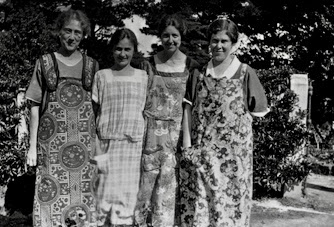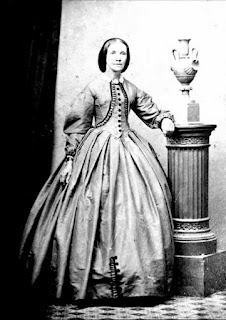11/52 Flowers: Dorothy Lillian Godlee 1889 - 1942
Dorothy, born in March 1889 in College Park, was to be the eldest of seven children. They attended East Adelaide Primary School.The Public Schools Annual Floral and Industrial Exhibition opened in November, 1900. The Governor applauded the cultivation of flowers by the scholars in a public school.’ ‘It was impossible,’ he believed, 'to over estimate the good work [of] teaching the child to love flowers’. There were prizes for flowers but Dorothy won first prize for her plain sewing, a ‘specimen on calico, showing hemming, seaming, stitching, gathering and setting on a band.’
When the Public Schools’ Exhibition opened in 1902 the journalist at the Register expressed patriotic amazement [at what] children under 16, ‘were daily being taught in the State Schools, and under a system of free education too! Far beyond the 3 Rs taught for a shilling a week in English schools.’ The Commissioner of Public Works opened the Exhibition - ‘no one in South Australia was a greater admirer of public schools than he’. ‘He did not think they could work more effectively for the benefit of the people than to teach children domestic economy and make the girls good housewives.’ Again Dorothy won prizes, for plain sewing and also for Lacework. Throughout her life Dots used these skills to make clothes for herself, her sisters and her children and to create things to sell at the Church fêtes which punctuated her years.
In 1904 Dorothy’s results were published for the University of Adelaide Junior Examination. She passed only two subjects: English Literature and Botany. By now she was fifteen and I suspect she left school.
The extended family was the background of Dots’ childhood. Her father’s sister lived with them from when she was eight. When Aunt Lottie was in England in 1897, Dorothy picked pansies for her at the grave of her grandmother, Aunt Lottie’s mother. Visits to Uncle Harris and Uncle Frank’s market gardens were frequent. Dots accompanied her siblings to visit aged relations, wrote to absent relations, was a bridesmaid at her cousin’s wedding, (her mother made her dress in pale blue silk, trimmed with Valencienne lace}. She joined her cousins for beach holidays, wearing mother’s home made sailor’s dress, (blue serge trimmed with white braid.)
The Kent Town Methodist Church provided a further social network. Here Theo, an accountant, was the treasurer and Charlotte played a leading role in the Sunday School. Her daughters, Dorothy, Marge, Mary, Norah and Jay all became Sunday School teachers. They met their friends and fiancés there. Dorothy and her sisters sang with the choir and also solos at events, they did the flowers and they organised fundraising bazaars.
In July, 1908, when Dorothy was 19 years old, her father, Theo, aged only 50, died from pneumonia. Charlotte was pregnant, had a son early in 1909, who then died in February, 1910. Auntie Lottie and Dorothy sprang into action to support a fragile, grieving Charlotte. Dorothy put to use the skills she had been taught at school : domestic economy. In the next few years, either Dorothy accompanied her mother to the country to recuperate, (for her ‘nerves’) and Auntie Lottie looked after the younger children, or both of them cared for the children and Charlotte was taken away by her sister, Mabel Hobbs. In January 1911 Dorothy and Charlotte went to New Zealand to stay with an old friend of Charlotte’s, known as ‘Aunt Florrie’. Charlotte needed these healing holidays to get back on track; it was the way they treated depression in those days. Her oldest daughter Dorothy was at her side, stitching in hand.
By the end of 1911 a memorial stained glass window was installed in the church to honour Theo and Charlotte seems to have recovered. They got on with life without husband and father. The oldest son, John, left home to make a living. I can’t help wondering if his leaving home so soon is connected to his father’s death; had Theo lived, John may have stayed at home and continued his education as the boys of other family friends did.
One of those boys was Syd Holder. He had been to school with John and involved with the Kent Town Methodist Sunday School. His frequent visits are mentioned in Charlotte’s letters: On Xmas Eve 1911, for example, Charlotte reports: ‘Here were a few drops of rain just after four so Reg and Syd took refuge and you know time goes so quickly in pleasant company. Then tea was announced before they thought of taking their departure although the rain had gone some time so we had the pleasure of their company…..Syd brought back the copper bowl (used for the flowers) after church and stayed until nearly ten.’
Sydney Ernest Holder was the sixth child of Frederick Holder who was the Premier of South Australia several times and eventually was voted into the new Federal Parliament where he was appointed as Speaker. He died at work, during an all night session, in the House of Representatives in Melbourne in 1909. It was the year after Dorothy’s father had died. Syd and Dots shared a powerful connection through common grief. Syd, unlike Dorothy’s brother, was able to study medicine and qualified as a doctor. Syd’s mother, Julia née Stephens, (Lady Holder), was the President of the Women's Christian Temperance Union. All the family were active Methodists.
I don’t know when Dorothy and Syd came to an understanding but in 1912 - Dorothy was 22 - Charlotte wrote to her daughters Margery and Mary : Dorothy’s dress looks very nice, simple of course. She hopes to wear it on Friday evening. Mary dear, when Lady Holder remarked that Syd had been down, instead of grinning as you say you did, you should have replied ‘It was kind of him to cheer their loneliness’. Clearly Mary, aged 14, understood enough to smirk and be ticked off by her mother. Dorothy spent years building up a ‘glory box’ and they are both mentioned together in Charlotte’s letters from 1912 onwards. ‘Syd and Dots came down on Tuesday night..’ In Summer of 1913 she received a ‘congratulatory epistle from Brian. He seems very charmed with the news Syd sends him.’ Does this mean they have announced their engagement? In January 1914 she writes: Dorothy went to Wandilta, [the home of the Holders] to dinner. Of course Miss Hood was dying for her to come, so Syd said, or something equivalent. Syd spent the afternoon with his young brother-in-law, [Dorothy’s youngest brother] so I daresay we shall see a marked improvement in his behaviour during the week, at least I hope so.’
It was a long engagement. Dorothy was twenty seven before they married in 1916 at the Kent Town Methodist Church. Perhaps they had to wait until Syd finished his medical qualifications, but they did not have long as a married couple before, Syd signed up with the Australian Imperial Force in September, on the 9th and they were married on the 28th. He embarked for Egypt on the 16th of January. 1917. Dorothy stayed at the family home in College Park. It was here that she gave birth to her baby, Alison, in July 1917.
Charlotte Godlee wrote approvingly about their home in Kadina: Dot’s house is lovely I am very pleased with it all, so roomy and nice. The outside too, clean and well kept. …Dorothy had a good many callers and her drawing room looked very sweet with bronze chrysanthemums out of their own garden.
Syd and Dorothy had three more children: John, 1920, Sheila, 1922 and Charlotte, whose birth in 1928 followed the death of Dorothy’s mother, earlier that year. She died in Dorothy’s home and Auntie Lottie came to live with them.
Syd and Dots were stalwarts of the Kadina community. In the Methodist Church Dots was President of the Ladies Guild: singing solos at concerts, organising the supper at dances, opening a Flower show, or the Strawberry Fête, arranging flowers for the Methodist Girls Club (sweet peas and maidenhair ferns), or judging the Fancy Dress completion where the winner of the most original costume went to the child dressed as a flour bag. She handed out medals at the Kadina High School Speech Night, or arranged the table decorations at the Old Scholars Dinner - almond blossom and violets. She won prizes for flower arrangements at the Kadina Show in 1922 and for her dahlias and salvia in 1927. She was involved in croquet, golf and bridge. She was a leader in Girl Guides and Rangers and the Wallaroo Mines Methodist Girls Club.
In 1942 both Syd and son John were involved in the War effort, Syd as a doctor in New Guinea and John with the RAAF. Alison was studying at the Adelaide Conservatorium, Sheila was studying at a technical college and the youngest daughter, Charlotte was at boarding school. She was 14. Dots seems to have been away form Kadina, ‘absent from the town for some months’. On October 6th, after being sick for several weeks, she died unexpectedly at the St Andrews Private Hospital. It was a total shock to all the family and the Kadina community. The Kadina and Wallaroo Times wrote in suitably flowery language:
'The end to a very graceful and useful life came last week when Mrs S E Holder concluded her pilgrimage and joined the vast number who have gone over the Great Divide. I need not stress that this loss is to us in Kadina and district is far greater than my pen is able to record.'
Sheila, John, Alison, Dots, Charlotte and Syd
References.
The Advertiser. (Adelaide)
Australian Dictionary of Biography for Frederick William Holder
The Australian Christian Commonwealth.
The Australian War Museum records
The Express and Telegraph.(Adelaide)
Hobbs Charlotte, Louisa, The Dear Old Letters. 2020, transcribed and edited by Sally O’Wheel.
The Kadina and Wallaroo Times
News (Adelaide).
The Register (Adelaide)
South Australian Register.
Wibberley Brian William, Someone Writing to Somebody, letters of BW Wibberley, 2022, transcribed and edited by Sally O’Wheel






Comments
Post a Comment